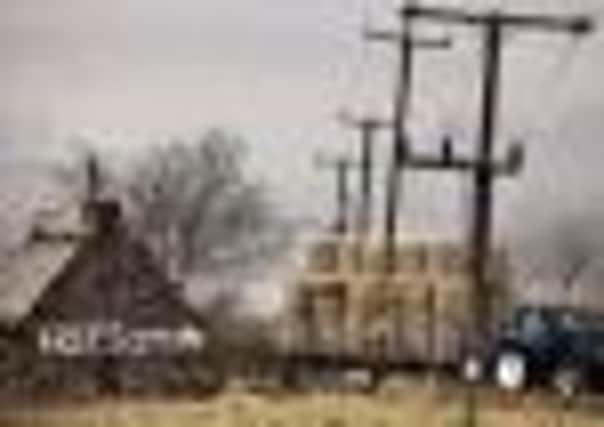Scottish independence referendum: Alex Salmond marches out into political no-man’s land


But when asked last night if Mr Salmond had unequivocal advice from the Lord Advocate and the Presiding Officer to suggest that his plan for a referendum would be safe from a legal challenge, the First Minister’s spokesman said nothing to suggest that he had.
Bullishly, the spokesman merely repeated his line that the Scottish Government was “entirely confident” that the legislation would be competent enough to hold a vote in autumn 2014.
Advertisement
Hide AdAdvertisement
Hide AdHowever, on a day that saw the great independence debate turn into a tale of two consultations – one from Edinburgh and the other from London – the prospect of the referendum finding itself in the middle of a legal minefield became almost inevitable.


The First Minister’s confidence, as his Cabinet signed off the Scottish Government’s referendum consultation, contrasted with the message sent out by the Scottish Secretary Michael Moore as he set out the UK government’s version of events.
According to Mr Moore, Holyrood does not have the powers to hold the referendum envisaged by the SNP.
The Scottish Secretary’s consultation put it in stark terms saying that a referendum “cannot be legally delivered by the Scottish Parliament.”
It added: “The Scottish Parliament only has power to legislate on matters that are devolved and has no power to legislate on matters that are reserved to the UK parliament.
“The Union of the Kingdoms of Scotland and England is one of those reserved matters.”
Therefore, Mr Moore argued, the solution was for the UK government to devise legislation that would ensure that a referendum was legally watertight, fair, based on a single question and decisive.
One way of doing that would be for Westminster to legislate directly for a referendum and impose a poll on the SNP, an option that Mr Moore will consult on and that Mr Salmond would have difficulty blocking.
Advertisement
Hide AdAdvertisement
Hide AdThe other method, which was outlined by the UK government yesterday, would be to legislate to give the Scottish Parliament the power to deliver a referendum – by using a so-called Section 30 order in the Scotland Act which transfers power from Westminster to Holyrood.
This would enable the coalition government to insert a sunset clause that would force the SNP to hold the referendum within an 18-month deadline.
The suggestion that a deadline would be imposed infuriated the SNP, who would have the power to reject the Section 30 order when it came before Holyrood.
Mr Moore toned down his language on this issue when he unveiled his consultation on “Scotland’s Constitutional Future” yesterday saying he wanted the poll “sooner rather than later” instead of insisting on a deadline.
But as Mr Moore’s document goes out to an eight-week period of consultation, the option of inserting a deadline remains within the document.
Another sticking point between the two governments is the coalition’s insistence that the Electoral Commission, a highly reputable organisation with huge experience in organising polls, must oversee the independence vote.
Clearly, much work remains to be done if the two administrations are to come to an agreement on a Section 30 order.
Or as the First Minister’s spokesman put it: “One obvious remedy would be for a Section 30 order without any strings or qualifications.”
Advertisement
Hide AdAdvertisement
Hide AdDespite the legal questions and Mr Moore’s proposals, the SNP will press ahead with its own plans for a referendum in the autumn of 2014 and will publish its consultation paper within two weeks.
From there, the bill, which will examine the “devo max” option, will go before Holyrood in January next year.
Barring legal challenges, the SNP majority in the Scottish Parliament should ensure that the bill will be passed by MSPs in autumn 2013.
The recommendations of the Gould Review into Scottish elections then requires that a six-month period must elapse between the law being in place and the poll being held.
Another Gould recommendation states that there should not be two separate elections on the same date ruling out the day in June 2014 when the European elections will be held.
That would give the SNP time to build up a patriotic feel-good factor capitalising on the 700th anniversary of the Battle of Bannockburn at midsummer, the Ryder Cup at Gleneagles and the Commonwealth Games in Glasgow before the big day in the autumn.
But the probability of these best-laid plans becoming unstuck in the law courts must be high.
Even if they are not challenged by politicians at Westminster, they could be challenged by a member of the public.
Advertisement
Hide AdAdvertisement
Hide Ad“We are in complicated territory where the law and politics become entangled,” said Alan Trench, honorary senior research fellow at University College London’s Constitution Unit.
“It is fairly likely that the referendum question will go to the Supreme Court. The fundamental problem that the Scottish Government has is that the referendum they want to hold is not one that the Scottish Parliament has the power to hold.
“Somebody will challenge its competence and the challenge will almost certainly be upheld.”
Should that happen there is a chance that a majority SNP government could end up in the same position as the minority SNP administration did in the last parliament – with its treasured dream of an independence referendum kicked well and truly into the long grass yet again.
“If that is indeed the outcome, the SNP will revert to familiar tactics.
Or as Mr Trench said: “It prolongs the constitutional debate and lets the SNP point the finger at London.”
More on the referendum debate: